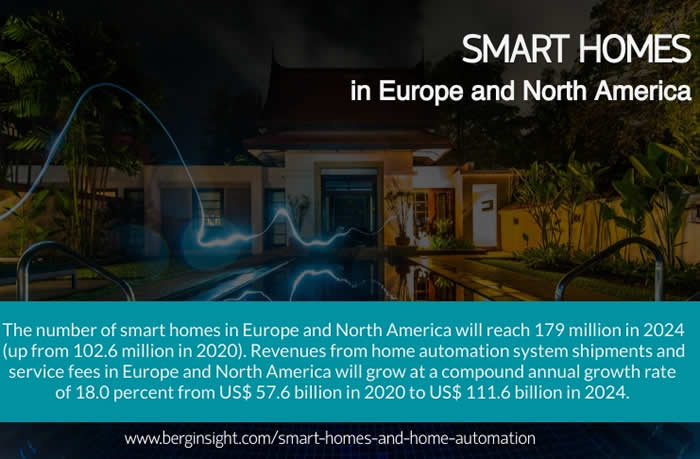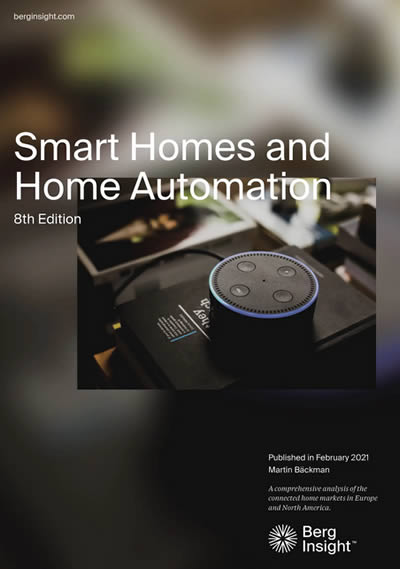As mentioned in a recent article on European IoT spending, the main category/area of investment in IoT is the consumer sector, especially the smart home automation solution segment. A look at the state – and future – of smart homes in Europe and North America.
The market growth in smart homes certainly isn’t limited to Europe alone. In fact, North America still leads in terms of smart home market penetration. Moreover, the growth is expected to continue strongly across the globe in the post-pandemic years. At the same time, the market continues to evolve, among others, in terms of providers, solutions, and buying patterns. An overview.
Revenues from home automation system shipments and service fees in Europe and North America will grow at a compound annual growth rate of 18.0 percent from US$ 57.6 billion in 2020 to US$ 111.6 billion in 2024.
The IoT market did relatively well in 2020, despite and, in some cases, because of the COVID-19 pandemic. For 2021 and especially the years beyond, things look rather good too, also outside of Europe.
The challenge with assessing the state of the IoT market is that it encompasses many types of IoT use cases, applications, industries, segments, etc. And there is indeed quite a difference between, among others, Industrial IoT, enterprise IoT, consumer IoT and vertical IoT segments such as medical IoT. Adding IIoT and Industry 4.0, one can even wonder if there is such a thing as an IoT market – but that’s another story.

The number of smart homes in Europe and North America in 2021 and beyond
But back to our smart homes in Europe and North America. Over the past years, spending in the consumer IoT segment, which traditionally is seen as the category in which smart home automation fits, gradually overtook spending in other areas.
Since the very start, we’ve been covering this evolution. It isn’t long ago that most IoT spending happened in discrete manufacturing, process manufacturing, transportation, utilities, etc., with the consumer segment slowly climbing up the ladder.
So, the growing relative importance of the consumer segment (as said, mainly smart home automation) was predicted and expected. It isn’t caused by the pandemic and the fact we’ve been spending more time at home. But, on the other hand, our being more at home due to the pandemic impacted both the growth of and types of investment in smart home automation spending. And that’s also what we see with smart homes in Europe and North America.
Participants in the smart home industry are now focusing increasingly on the software side of the solutions to develop compelling use cases. Ease of installation, integration with other IoT devices and security will remain key priorities for consumers.
Earlier in 2021, independent industry analyst and consulting firm Berg Insight announced that the number of smart homes in Europe and North America reached a total installed base of 102.6 million smart homes in 2020.
As said, North America leads, with an installed base of 51.2 million smart homes end 2020 to be precise. This means that between 2019 and 2020, the market grew by 18.7 percent with a limited negative impact due to the pandemic. One of the only things that changed for obvious reasons is that consumers shifted their buying from traditional stores to online channels, with online sales of smart home products surging.
Looking further ahead, Berg Insight expects that by 2024 close to 78 million homes in North America will be “smart,” that’s around 53 percent of all homes in the region. In Europe, the installed base is expected to increase from 51.4 million smart homes to over 100 million at the end of 2024 (around 42 percent of all homes in the region).
Differences in preferred smart home solutions and providers in North America and Europe
On the level of smart home products (note there’s a difference between having some products and a real smart home), interactive home security systems have become the most common type of smart home systems in North America. The largest home security providers, according to Berg Insight include ADT, Vivint, and Comcast.

In Europe, traditional home automation systems and DIY solutions are more common as whole-home systems. That’s good news for European home automation integrators, electricians/experts with home automation expertise, and various types of companies offering such capabilities, including Somfy, Centrica, Deutsche Telekom, eQ-3, etc.
Among the most popular smart home products overall, we note smart thermostats, smart light bulbs, smart security cameras, smart door locks, smart plugs, and smart speakers.
Despite the differences in smart home buying (and product/system) patterns between Europe and North America, there is a diverse market of providers everywhere. Which partner is best, among others, depends on whether buyers go for a DIY approach, home automation system, security systems, and so on.
With the mentioned providers in mind, we see a mix of incumbent OEMs, new entrants, classic home automation experts, telecom providers, DIY solution providers, and home security experts, whereby solution providers sell products from various OEMs or specialized ecosystems.
We often see that consumers start with DIY solutions of larger vendors until they want more advanced products in their smart home mix and need expert integrator help. This is a phenomenon we’ll notice more and more since, all in all, the smart home market still has tremendous growth potential with ample use cases.
We once looked at the fast-growing list of use cases in home automation with less obvious use cases. Today, that list has only grown, and here, the pandemic plays a role, among others, with the awareness around air quality and health. Since people started working at home, we’ve also seen an uptake in solutions to make the home office more comfortable or even possible, with lighting as one prominent example.
Many people spent more time at home during the pandemic and thus became interested in smart home products that improve their home.
The opportunity for experts and vendors of smart home solutions in North America and Europe
Vendors realize that potential and know that interoperability, connectivity, ease of use/installation, future readiness, compelling use cases, and security are key.
Per Berg Insight, products and systems related to security and energy management have so far been the most successful as they provide a clear value for consumers.
We’ll cover the ecosystems of smart home solutions and some collaborations in the market in a separate article. To understand them and the growth of smart homes in Europe and North America, it’s also important to point to the differences in connectivity solutions and standards. In Europe, for example, KNX is a prominent standard in home automation and building automation.
There are also ecosystems to know about. Schneider Electric, for instance, has a certification in home automation for its EcoXpert partners for its Wiser range but is also part of a connectivity ecosystem that includes companies such as Somfy, Danfoss, and others.
Last but not least, it’s important to note that the offerings for home automation of these companies also overlap with building automation solutions and are often part of offerings outside the smart home as everything gets more connected. As we shift towards a hybrid work model, it will especially be interesting to see how the smart office and smart home connect and overlap if people want their smart solutions to work at home, work in the office, and work anywhere they can.
More companies here and in the Berg Insight report “Smart Homes and Home Automation” (Europe and North America).


